Urban Mobility Design
The Dutch-est Place in Boulder, CO?
Adapting Dutch-inspired transportation solutions to North American cities and towns is an exciting and challenging project. Every new plan is an opportunity to push the state of our practice forward. Integrated Mobility Advisor Zach Vanderkooy shares his observations of one recent and ambitious example of applying Dutch mobility inspiration in the U.S. context is in Boulder, Colorado, the home of Mobycon’s newest North American office.
The neighborhood is Boulder Junction, a new 160 acre (65 hectare) mixed-use development in the geographic center of the city. The neighborhood will bring 1500+ much needed new housing units to Boulder (1/4 of them affordable) along with offices, retail, parks, light industry, and a major public transportation hub on a former industrial site. It also presents a rare opportunity to completely re-make a street grid from scratch.
This rapidly changing neighborhood has obvious Dutch influences in the design of its public realm; a logical choice for inspiration given the City of Boulder’s climate and safety goals. Construction is still underway, and the story of Boulder Junction is far from complete. It is yet to be seen if public policy and market forces are aligned to deliver on the low-car, transit-oriented, vision for the community. But the early implementation of its physical infrastructure has me excited for the future of Boulder, and for the future of transportation planning and design in North America.
Let’s take a closer look…
TOD with a Twist
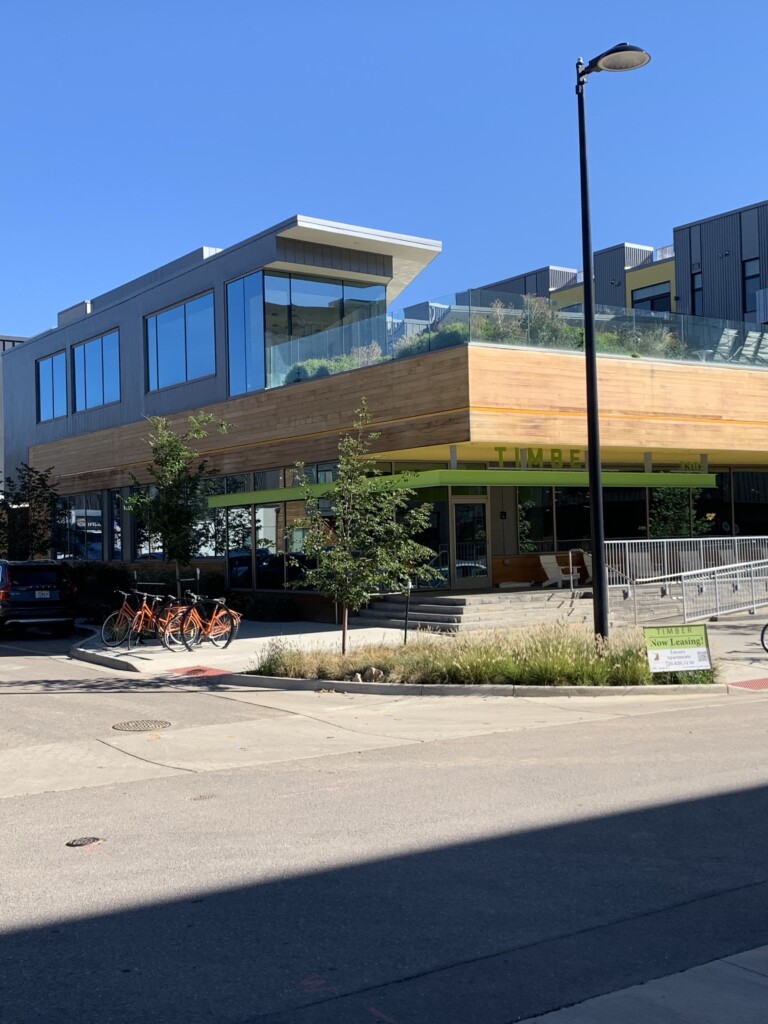
At quick glance, Boulder Junction is a classic transit-oriented development (TOD). Formerly a freight rail depot, the neighborhood is envisioned as a high-density regional transportation hub with abundant micromobility options to link to the rest of the city. The area is served by high-capacity buses, but the long-term solution is modern commuter rail.* Unlike the suburban and greenfield developments that typically are associated with TODs in North American practice, Boulder Junction is integrated into the central urban fabric of the city.
*The many challenges, victories, and heartbreaks of funding rail service between Boulder and Denver is a long and not-yet-finished story. But that’s a different post.
Taming Traffic with Intuitive Design
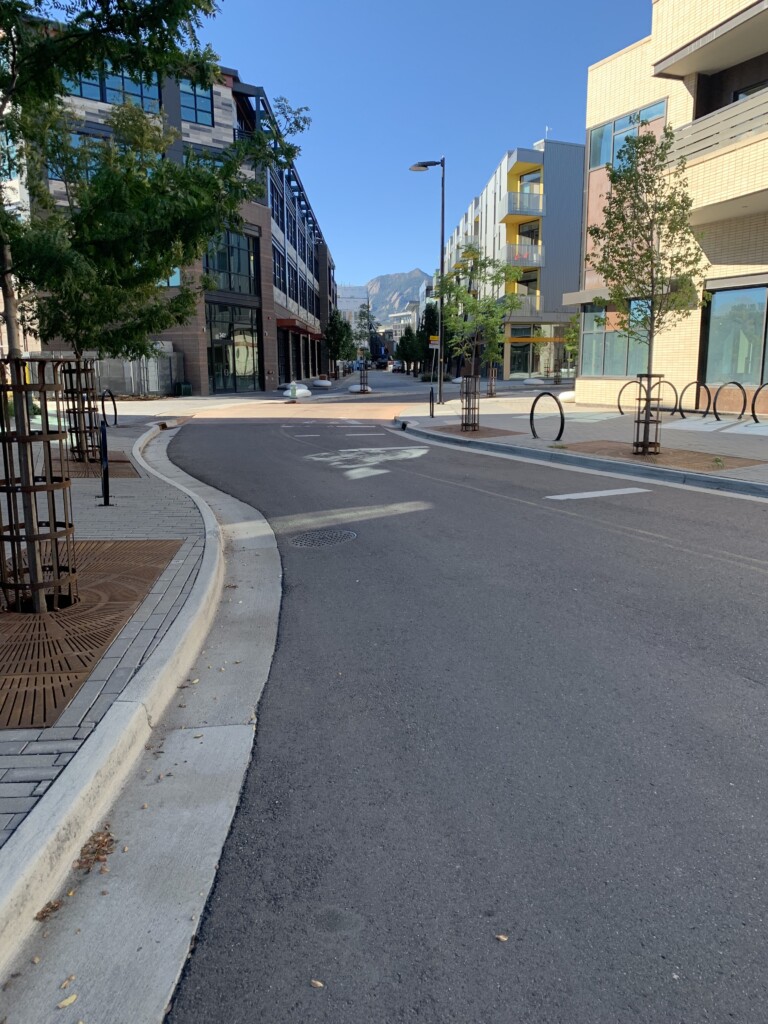
If there’s one lesson of Dutch traffic engineering that North American practice would most benefit from universally adopting, it’s this: let the design of the street dictate speed. If you depend on signs to tell people how fast to drive, you’ve already failed. In this case, chicanes in the roadway introduce friction to reduce speed, while plentiful off-street bike parking and plantings add visual clues to the presence of people on foot and two-(or three-) wheels. When the design insists on slow speeds (<20 mph/30 kmh), people driving and rolling on all types of cycles can share space safely and comfortably without the need for specialized infrastructure. A raised crossing at the sharpest bend of a corner performs double duty as both a marker of pedestrian priority and a speed hump for slowing motorized vehicles. Want to go even more Dutch? Swap the asphalt with rough-textured pavers, ditch the curb, and make the car lanes even narrower
Shared Street #1: The Plaza
A well-designed shared street should just barely feel like it’s ok to drive a car on it. The idea is to create a low-stress egalitarian space where people are invited to linger and all users share responsibility for interacting safely. This version emphasizes sense of place over traffic flow, serving as a “you are here” stamp; a gateway to the neighborhood and the doorstep of the future transit hub. A mix of textures, grades, and a subtle half-curb intentionally blur the lines of where the plaza ends and the street begins. It isn’t perfect – this first iteration is oversized and isn’t aggressive enough in its traffic calming treatments to function at the posted 10 mph (16 kmh) speed limit. But those potential flaws might be less detrimental when the neighborhood is fully activated with people. Its open and flexible space, high visibility, and adjacent commercial land uses, make this street ideal for impromptu street gatherings, festivals, and events.
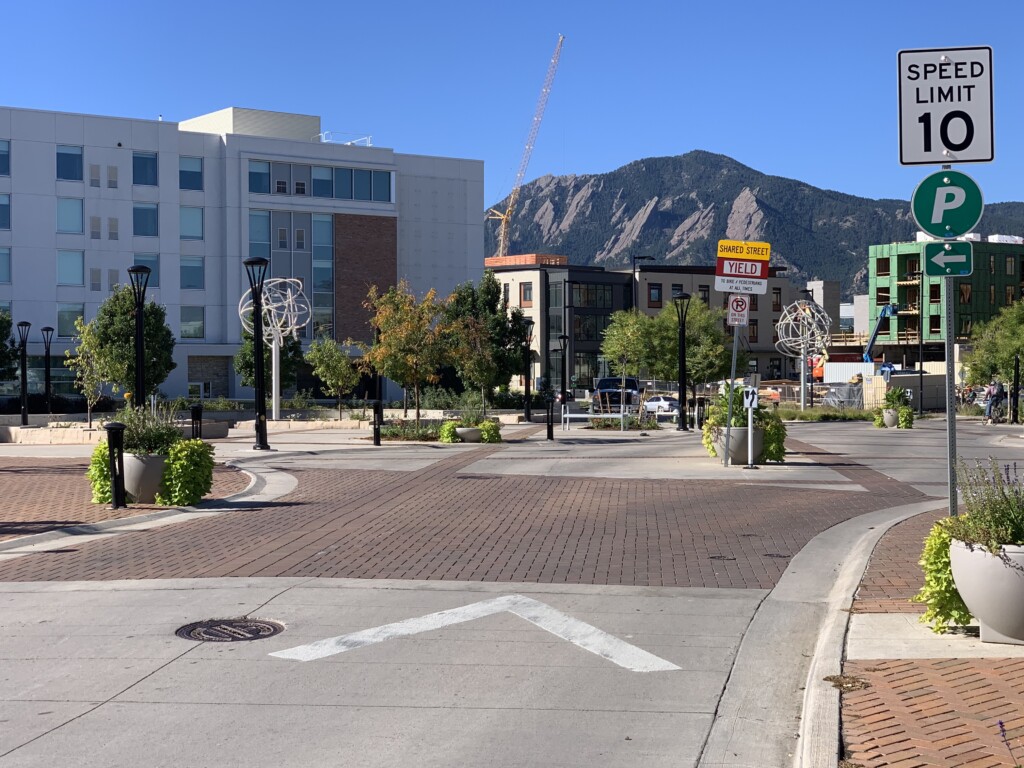
Shared Street #2: The Cozy Alley
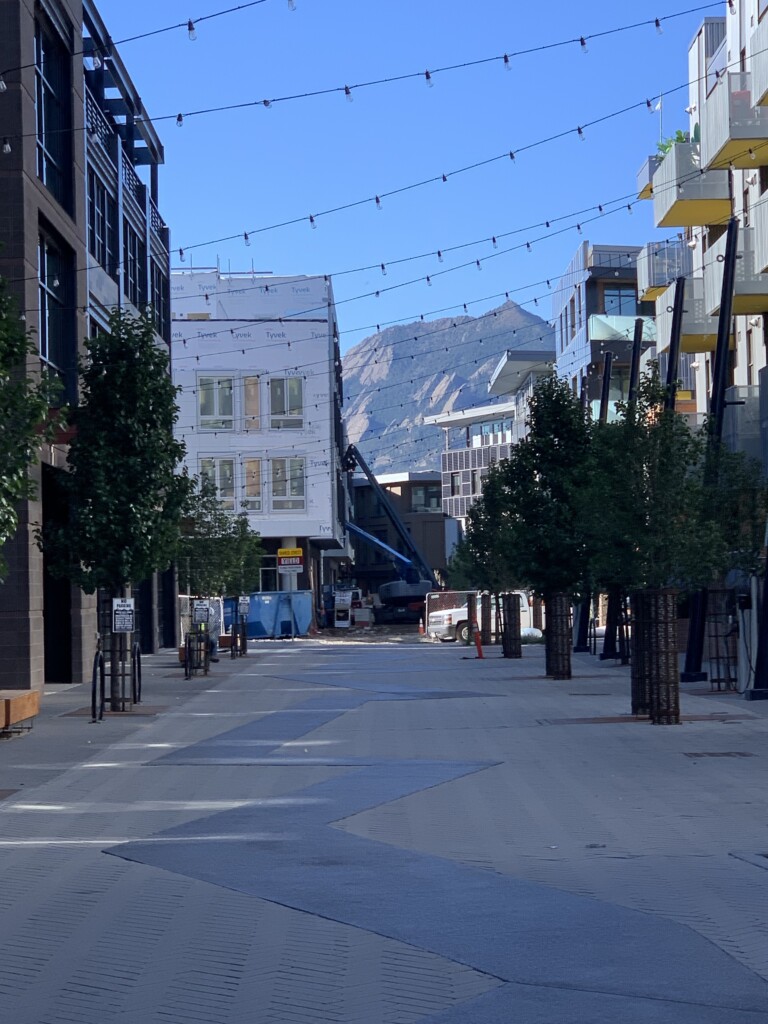
Just a few steps away in the adjacent Steelyards district, this playful version of the shared street has a more private, homey ambience. The width isn’t different from a standard local access street, but the materials and markings make it unique. A zig-zag pattern in the pavers invites visitors to casually wander and disabuses the notion that streets must segment users into lanes to be legible. Lighting strung across the street from upper floors of the adjacent buildings draws attention to the sky and Boulder’s iconic Flatirons, enclosing the ground-level offices and upper floor apartments in something that feels like an outdoor living room. This type of snug-but-welcoming, private-feeling-but-public space takes a lot of cues from Dutch urbanism. It’s as much an expression of culture as a traffic planning philosophy.
Looking Down From Above
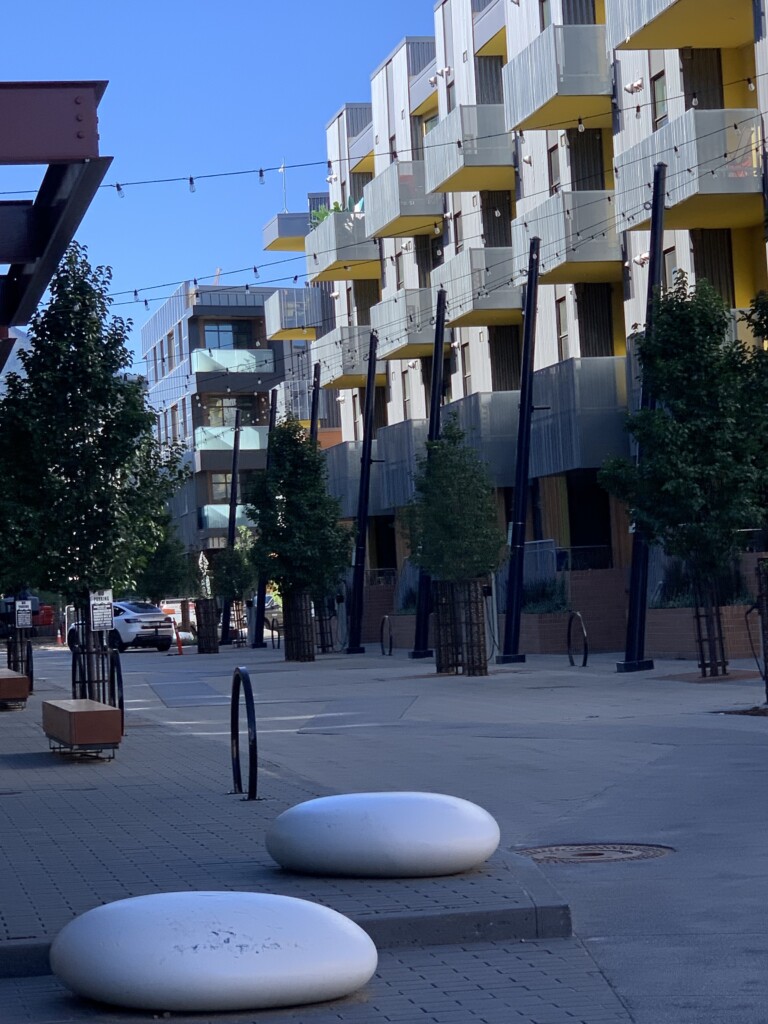
The influential Canadian-American urbanist Jane Jacobs famously coined the term ‘eyes on the street’ to describe the safety and community-building benefits of human (not car) density in urban neighborhoods. But what to do when the people aren’t there (yet)? Many North American communities suffer from chronic low population density, but in the case of the Boulder Junction, the planned development just isn’t finished. An interim architectural solution is deployed here, with street-facing balconies in the residential units suggesting the presence of people, even if the units are not yet occupied.
So How is It Working?
These images of Boulder Junction, taken in the Autumn of 2022, are full of carefully considered details to craft a people-friendly environment. But you can’t make a vibrant mixed-use neighborhood without the neighbors. At only a fraction of its eventual population, it’s too early to judge how successful the urban design choices of Boulder Junction will be. The DNA of Dutch transportation experience is plainly visible in the fabric of Boulder’s newest neighborhood, but the implementation is distinctly local. I’m looking forward to watching this place mature. No matter how its success is measured going forward, the lessons learned will inspire and inform the next iteration of North American street design.
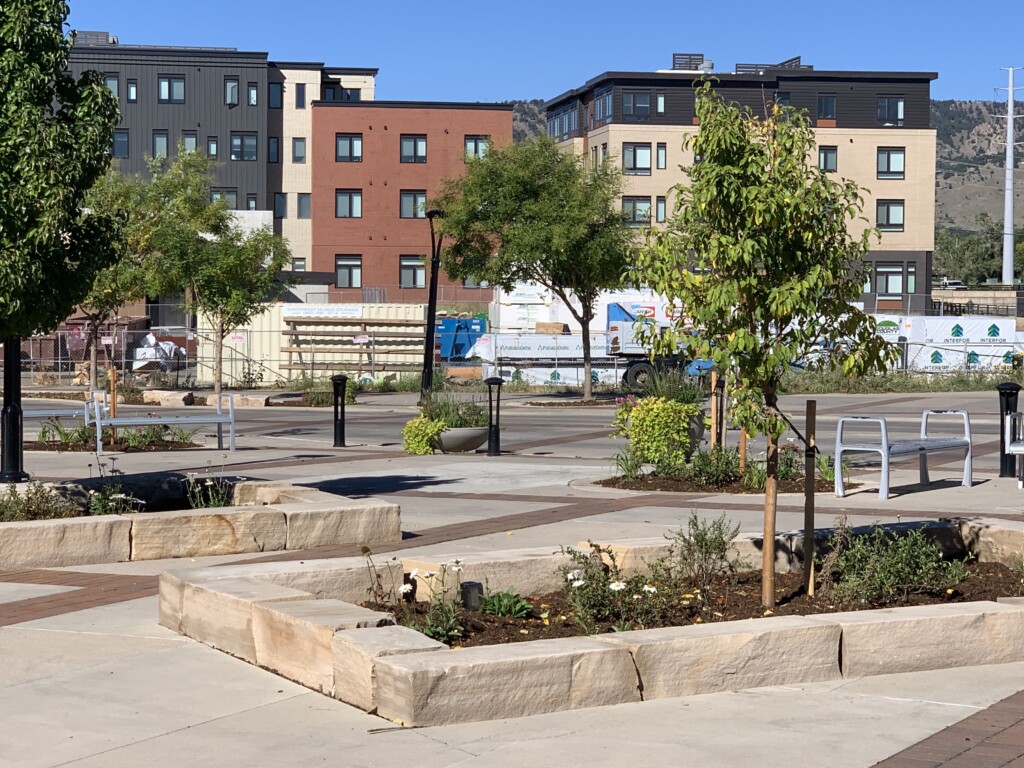
 ">
">Zach Vanderkooy
‘Dutch urbanism may seem like magic at first glance, but it’s the result of courageous (and replicable) choices made by human beings. Experience from the Netherlands has tremendous power to inspire and inform the creativity we need to build more resilient, safe, equitable and prosperous communities.’

